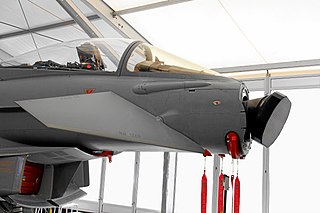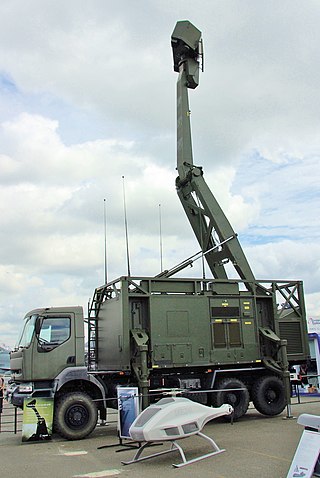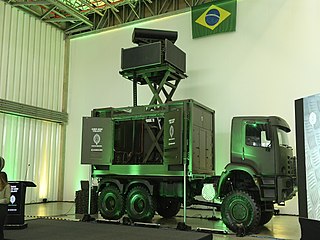Operators
 Egypt: in service with the Egyptian Air Defense Forces.
Egypt: in service with the Egyptian Air Defense Forces.
ESR-32A is an Egyptian two-dimensional L band aerial scanning and early-warning radar. It was unveiled during EDEX 2018. [1] [2] [3] [4] [5]
The radar is in service, and after its practical success, the armed forces developed three-dimensional radars with phased arrays with a range of 450 kilometers, and it was announced in the second edition of the exhibition in 2021. [1]

The Northrop Grumman E-2 Hawkeye is an American all-weather, carrier-capable tactical airborne early warning (AEW) aircraft. This twin-turboprop aircraft was designed and developed during the late 1950s and early 1960s by the Grumman Aircraft Company for the United States Navy as a replacement for the earlier, piston-engined E-1 Tracer, which was rapidly becoming obsolete. The aircraft's performance has been upgraded with the E-2B and E-2C versions, where most of the changes were made to the radar and radio communications due to advances in electronic integrated circuits and other electronics. The fourth major version of the Hawkeye is the E-2D, which first flew in 2007. The E-2 was the first aircraft designed specifically for AEW, as opposed to a modification of an existing airframe, such as the Boeing E-3 Sentry. Variants of the Hawkeye have been in continuous production since 1960, giving it the longest production run of any carrier-based aircraft.

An active electronically scanned array (AESA) is a type of phased array antenna, which is a computer-controlled antenna array in which the beam of radio waves can be electronically steered to point in different directions without moving the antenna. In the AESA, each antenna element is connected to a small solid-state transmit/receive module (TRM) under the control of a computer, which performs the functions of a transmitter and/or receiver for the antenna. This contrasts with a passive electronically scanned array (PESA), in which all the antenna elements are connected to a single transmitter and/or receiver through phase shifters under the control of the computer. AESA's main use is in radar, and these are known as active phased array radar (APAR).

3D radar provides for radar ranging and direction in three dimensions. In addition to range, the more common two-dimensional radar provides only azimuth for direction, whereas the 3D radar also provides elevation. Applications include weather monitoring, air defense, and surveillance.

The Crotale is a French, all-weather, short-range surface-to-air missile system developed to intercept airborne ranged weapons and aircraft, from cruise or anti-ship missiles to helicopters, UAVs or low-flying high-performance fighter aircraft. It was developed by Thomson CSF Matra and consists of a mobile land-based variant as well as various naval ones.

An early-warning radar is any radar system used primarily for the long-range detection of its targets, i.e., allowing defences to be alerted as early as possible before the intruder reaches its target, giving the air defences the maximum time in which to operate. This contrasts with systems used primarily for tracking or gun laying, which tend to offer shorter ranges but offer much higher accuracy.

The Saab Giraffe Radar is a family of land and naval two- or three-dimensional G/H-band passive electronically scanned array radar-based surveillance and air defense command and control systems. It is tailored for operations with medium- and Short Range Air Defense (SHORAD) missile or gun systems, or for use as gap-fillers in a larger air defense system.
Electronics and Radar Development Establishment (LRDE) is a laboratory of the Defence Research & Development Organisation (DRDO), India. Located in C.V. Raman Nagar, Bengaluru, Karnataka, its primary function is research and development of radars and related technologies. It was founded by S. P. Chakravarti, the father of Electronics and Telecommunication engineering in India, who also founded DLRL and DRDL.

The SABER Radar is a project of the Brazilian Army, with the objective of developing 100% Brazilian technology air defense radars. They are being developed by CTEx and produced by BRADAR, a Brazilian company part of Embraer Defense and Security group, with funds from the Ministry of Science and Technology. The tracking system can track both air and ground targets and has a range of up to 60 kilometers and up to 5,000 meters altitude. The radar system is unique in that it can be integrated into weapon systems or missile-based anti-aircraft guns.

The P-18 or 1RL131Terek is a 2D VHF radar developed and operated by the former Soviet Union.

The P-14 is a 2D VHF radar that was developed and operated by the Soviet Union.

Matla-ul-fajr is an Iranian VHF 3D radar. It was first seen in military parades. It was stated that Matla-ul-fajr covered the whole Persian Gulf. The range of Matla-ul-Fajr-1 is 300 km and the max altitude is 20,000 m. When fully set up, the height of the system reaches eight meters and it uses 12 "Yagi" antennas installed in two rows. The whole system, containing the antennas, setup instruments, processing, controlling and displaying units, communication devices and power generator are all installed on a trailer to achieve a very good mobility. The radar is also equipped with ECCM to survive in an e-warfare environment.

The Ground Master 400 (GM400) is a mobile long range radar system manufactured by Thales. GM400 is a fully digital active electronically scanned array long-range air defense 3D radar, offering detection from very high to very low altitudes. It tracks a wide range of targets from highly maneuverable tactical aircraft flying below several hundred feet to the unconventional small radar cross section devices, such as UAVs or cruise missiles.

The ELM-2084 is an Israeli ground-based mobile 3D AESA multi-mission radar (MMR) family produced by ELTA, a subsidiary of Israel Aerospace Industries.
Kalkan is a phased array 3D search and track radar system for low and medium range air defense mission operations.

The AN/TPY-2 Surveillance Transportable Radar, also called the Forward Based X-Band Transportable (FBX-T) is a long-range, very high-altitude active digital antenna array X band surveillance radar designed to add a tier to existing missile and air defence systems. It has a range of 2,900 mi. Made by Raytheon, it is the primary radar for the Terminal High Altitude Area Defense (THAAD) missile system, but also cues the AN/MPQ-53 radar of the MIM-104 Patriot system. Patriot PAC-3 is a lower-altitude missile and air defense system than THAAD.
Aselsan EIRS (Early Warning RADAR System) is a new generation S-Band radar, developed for long range early warning purposes, with AESA and digital beamforming antenna architecture. The system developed by Turkish company Aselsan. In addition to air-breathing air targets, EIRS also has the ability to detect and track Ballistic Missiles and targets with stealth technology / low RKA from long range.

The AN/TPS-63 was a medium range, Two-dimensional, L band radar system utilized by the United States Marine Corps from the early 1980s until finally retired in 2018. This mobile radar was developed by Northrop Grumman and complimented the AN/TPS-59 long range radar by providing 360 degree, gap-filling coverage of low altitude areas. Because it was more mobile, the TPS-63 was also employed as the first radar ashore during amphibious operations until the larger and more capable AN/TPS-59 was established. The TPS-63 was used in combat operations during the Gulf War, the 2003 invasion of Iraq and subsequent operations in Iraq and Afghanistan. The TPS-63 was eventually phased out of service in 2018 as it was replaced by the AN/TPS-80 Ground/Air Task Oriented Radar.
ESR-32B is an Egyptian bi-dimensional L band for air and sea surveillance and early-warning radar. It was unveiled in EDEX 2018 by Benha Electronic Industries Company.